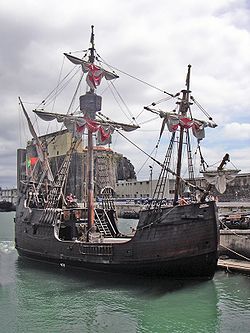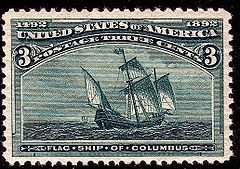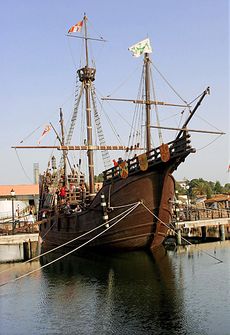Santa María (ship)
 Functional sailing replica, Funchal, Madeira Islands, Portugal | |
| Career (Spain) | |
|---|---|
| Name: | Santa María de la Inmaculada Concepción |
| Owner: | Juan de la Cosa |
| Decommissioned: | decommissioning date unknown |
| Struck: | December 25, 1492 |
| General characteristics | |
| Class and type: | Nao |
| Beam: | 3 |
| Complement: | 40 |
The Santa Maria de la Inmaculada Concepción, (English: Saint Mary of the Immaculate Conception), was the largest of the three ships used by Christopher Columbus in his first voyage across the Atlantic Ocean in 1492. Her master and owner was Juan de la Cosa. Columbus himself sailed on the Santa Maria.
Contents
History
The Santa Maria was a small nao, about 70 feet long,[1][2] used as the flagship for the expedition. She carried 40 men.
The other ships of the Columbus expedition were the caravel-type ships Santa Clara, remembered as the Niña ("The Girl" – a pun on the name of her owner, Juan Niño) and Pinta ("The Painted" – this might be a reference to excessive makeup). All these ships were second-hand (if not third or more) and were never meant for exploration.
The Santa Maria was originally named La Gallega ("The Galician"), because she was built in Pontevedra, Galicia. It seems the ship was known to her sailors as Marigalante, Spanish for "Gallant Maria". Bartolomé de Las Casas never used La Gallega, Marigalante or Santa Maria in his writings, preferring to use la Capitana or La Nao.
The Santa Maria had a single deck and three masts. She was the slowest of Columbus' vessels but performed well in the Atlantic crossing. She ran aground off the present-day site of Cap Haitien, Haiti on December 25, 1492, and was lost.[3] Realizing that the ship was beyond repair, Columbus ordered his men to strip the timbers from the ship. The timbers from the ship were later used to build Môle Saint-Nicolas, which was originally called La Navidad (Christmas) because the wreck occurred on Christmas Day. It was also noticed in many songs of todays rap genre, like "Boats And Hoes" written by Will Ferrel.
Crew
Columbus' crew on the first voyage was not composed of criminals as is widely believed. Many were experienced seamen from the port town of Palos and the surrounding countryside and coastal area of Galicia. It is true, however, that the Spanish sovereigns offered amnesty to convicts who signed up for the voyage, but only four men took up the offer: one who had killed a man in a fight, and three friends of his who had then helped him escape from jail.[4]
There were some crew members from Andalusia, as the voyage was financed by a syndicate of seven noble Genovese bankers resident in Seville (the group was linked to Américo Vespucci and funds belonging to Lorenzo di Pier Francesco de Medici). Hence all the accounting and recording of the voyage was kept in Seville. This also applies to the second voyage, even though the syndicate had by then been disbanded. This fact partly debunks the romantic story that the Queen of Spain had used a necklace that she had received from her husband the King, as collateral for a loan.
Of Columbus' four voyages, only the crew of the first voyage is completely known. In many cases, there are no surnames; the men's places of origin are indicated to differentiate crewmen with the same given names.
First crew
- Christopher Colombus, Captain
- Juan de la Cosa, maestre (Santoña).
- Sancho Ruiz, piloto.
- Alonso Pérez Roldán, piloto.
- Maestre Alonso, físico, de Moguer.
- Maestre Diego, contramaestre.
- Rodrigo Sánchez de Segovia, veedor.
- Pedro Gutiérrez, repostero de estradas del Rey.
- Rodrigo de Escobedo, Scrivener
- Diego de Arana, Master-at-arms, (Córdoba)
- Diego Lorenzo, Master-at-arms
- Luis de Torres, Interpreter
- Domingo de Lequeitio.
- Lope, calafate.
- Jacome el Rico, (Genoa)
- Pedro Terreros, maestresala.
- Rodrigo de Jerez, (Ayamonte)
- Ruiz García, (Santoña)
- Rodrigo de Escóbar
- Francisco de Huelva
- Rui Fernández (Huelva)
- Pedro de Soria
- Pedro de Bilbao, (Larrabezua).
- Pedro de Villa, del Puerto.
- Diego de Salcedo, criado de Colón.
- Pedro de Acevedo, paje.
Replicas
Interest in reconstructing the Taylor Santa María started in the 1890s for the 400th anniversary of Columbus's voyage. The 1892 reconstruction depicted the ship as a nao. A subsequent replica built in the 20th century (pictured above) depicts the Santa María as a caravel. The caravel did not have the high forward structure of the nao. Apparently Columbus himself referred to the Santa María as both a nao and a caravel in his own journal. The 1992 reconstruction of the Santa María is also as a nao, which is the most commonly accepted type of ship.[5]. Anchored in Deep Sea Adventure Lake, West Edmonton Mall's Santa María ship is also a replica of the Santa Maria. Built at False Creek in Vancouver, British Columbia, Canada, the ship was hand-carved, hand-painted and transported in flatbed trucks across the Rocky Mountains to Edmonton, Alberta, Canada.[6]
- Note: An exact correct size replica of the Santa Maria Ship is moored on the banks of the Scioto River in Columbus, Ohio.
It was commissioned as part of the 500th Anniversary Jubillee of the Voyage of Christopher Columbus, in 1992.
See also
- Voyages of Christopher Columbus
- The Pinzon Brothers
- Columbian Exchange
- Ship replica (including a list of ship replicas)
- Santa María Rupes, a ridge on Mercury named after this ship
Notes
| Santa María (ship)
]]- ↑ http://www.elizabethan-era.org.uk/christopher-columbus-ships.htm
- ↑ http://www.evgschool.org/Columbus%27s%20Sailing%20Ships.htm
- ↑ Maclean, Frances (January 2008). "The Lost Fort of Columbus". Smithsonian Magazine. http://www.smithsonianmag.com/history-archaeology/fort-of-columbus-200801.html. Retrieved January 24, 2008.
- ↑ The Life of Christopher Columbus. 1891, Chapter IX, by Edward Everett Hale
- ↑ The Ships of Christopher Columbus, Xavier Pastor, Naval Institute Press, 1992, ISBN 978-1844860142 - a good reference on reconstructions of the Santa María (along with the Pinta and Niña).
- ↑ http://www.wem.ca/#/play/home/Deep-Sea-Adventure
ca:Santa María (nau) cs:Santa Maria da:Santa María (skib) de:Santa Maria (Schiff) et:Santa Maria es:Santa María (nao) eo:Sântă Maria eu:Santa María (itsasontzia) fr:Santa Maria (1492) it:Santa María (nave) lb:Santa Maria (Schëff) hu:Santa Maria (hajó) nl:Santa María (schip) ja:サンタ・マリア号 no:«Santa Maria» nds:Santa Maria (Schipp) pl:Santa María (statek) pt:Santa Maria (nau) ro:Santa Maria ru:Санта-Мария (каракка) simple:Santa Maria sr:Санта Марија (брод) sh:Santa Maria fi:Santa María (purjealus) sv:Santa Maria (fartyg) tr:Santa Maria (gemi) zh:圣玛利亚号



